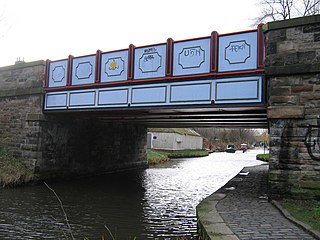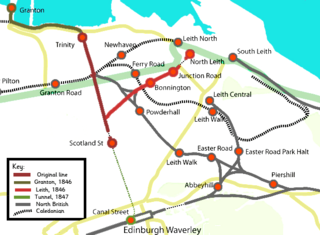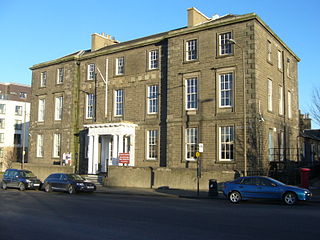| Founded | 1880 |
|---|---|
| Based in | Granton, Edinburgh |
| Website | www |

The Forth Corinthian Yacht Club is located in Granton, in Edinburgh, Scotland, on a site overlooking the Firth of Forth
| Founded | 1880 |
|---|---|
| Based in | Granton, Edinburgh |
| Website | www |

The Forth Corinthian Yacht Club is located in Granton, in Edinburgh, Scotland, on a site overlooking the Firth of Forth
In 1880, several gentlemen met in a room at the Granton Hotel (now HMS Claverhouse) and formed the Forth Corinthian Yacht Club. [1]
The hotel was designed by the architect William Burn in 1838 and is situated in Granton Square. Granton was very much the creation of the 5th Duke of Buccleuch, based around the harbour whose main function was the export of coal from the Duke's mines in the Lothians.
The Forth Corinthian Yacht Club is about amateur sailors coming together to make sailing affordable for all. Wherever possible, members contribute their own skills and labour to the work of the club and the experience of long-standing members is shared with new members and beginners.


The Firth of Forth is the estuary, or firth, of several Scottish rivers including the River Forth. It meets the North Sea with Fife on the north coast and Lothian on the south.

Her Majesty's Yacht Britannia, also known as the Royal Yacht Britannia, is the former royal yacht of the British monarchy. She was in service from 1954 until 1997. She was the 83rd such vessel since King Charles II acceded to the throne in 1660, and is the second royal yacht to bear the name, the first being the racing cutter built for the Prince of Wales in 1893. During her 43-year career, the yacht travelled more than a million nautical miles around the world to more than 600 ports in 135 countries. Now retired from royal service, Britannia is permanently berthed at Ocean Terminal, Leith in Edinburgh, Scotland, where it is a visitor attraction with over 300,000 visits each year.

The Forth Canoe Club, founded in 1934, is Scotland's oldest surviving canoe club. It is a founding member of the Scottish Canoe Association.
Silverknowes is a district of Edinburgh, Scotland. Silverknowes lies to the northwest of the city. The district contains over 2000 homes, ranging in size from bungalow to semi-detached housing, much of it built during the mid-twentieth century.

Granton is a district in the north of Edinburgh, Scotland. Granton forms part of Edinburgh's waterfront along the Firth of Forth and is, historically, an industrial area having a large harbour. Granton is part of Edinburgh's large scale waterfront regeneration programme.
Harold Andrew Raeburn was a Scottish mountaineer. He was one of the most prominent British mountaineers of his era with several first ascents. He was mountaineering leader on the initial 1921 British Mount Everest reconnaissance expedition.

Burntisland railway station is a railway station in the town of Burntisland, Fife, Scotland. The station is managed by ScotRail and is on the Fife Circle Line.

Sir John Donald Pollock FRSE LLD was a Scottish physician, industrialist and philanthropist who served as Rector of the University of Edinburgh from 1939 to 1945 and gave land to the University to build halls of residence. Pollock Halls of Residence were built on the site, and were named for him.
The Edinburgh and Northern Railway was a railway company authorised in 1845 to connect Edinburgh to both Perth and Dundee. It relied on ferry crossings of the Firth of Forth and the Firth of Tay, but despite those disadvantages it proved extremely successful. It took over a short railway on the southern shore of the Forth giving a direct connection to Edinburgh, and it changed its name to the Edinburgh, Perth and Dundee Railway.

The Edinburgh, Leith and Newhaven Railway was a railway company formed in 1836 to connect the city of Edinburgh with the harbours on the Firth of Forth. When the line connected to Granton, the company name was changed to the Edinburgh, Leith and Granton Railway. It opened part of its route in 1846, but reaching the centre of Edinburgh involved the difficult construction of a long tunnel; this was opened in 1847. It was on a steep incline and was worked by rope haulage.
Corinthian Yacht Club may refer to:

HMS Claverhouse was a shore establishment of the British Royal Navy, based at Granton, Edinburgh. It is a listed building, used as a training centre for E Squadron, 205 (Scottish) Field Hospital (Volunteers).
Events from the year 1880 in Scotland.
Events from the year 1824 in Scotland.
Events from the year 1806 in Scotland.

Trinity Chain Pier, originally called Trinity Pier of Suspension, was built in Trinity, Edinburgh, Scotland in 1821. The pier was designed by Samuel Brown, a pioneer of chains and suspension bridges. It was intended to serve ferry traffic on the routes between Edinburgh and the smaller ports around the Firth of Forth, and was built during a time of rapid technological advance. It was well used for its original purpose for less than twenty years before traffic was attracted to newly developed nearby ports, and it was mainly used for most of its life for sea bathing. It was destroyed by a storm in 1898; a building at the shore end survives, much reconstructed, as a pub and restaurant called the Old Chain Pier.
Prof Tom Leadbetter Cottrell DSc FRSE was an influential Scottish chemist. He is best remembered as a co-founder and first Principal of the University of Stirling, and founder of the Macrobert Arts Centre in Stirling. He wrote several popular academic textbooks on the subject of chemistry.

Forth is one of the seventeen wards used to elect members of the City of Edinburgh Council. Established in 2007 along with the other wards, it currently elects four Councillors. Its territory covers communities in the north of the city between Ferry Road and the coast on the Firth of Forth, including Granton, Newhaven, Pilton, Trinity, Victoria Park and Wardie, some of which historically fell within the boundaries of Leith. A 2017 boundary change caused the loss of the Muirhouse neighbourhood, but housebuilding elsewhere meant the overall population increased slightly. In 2019, the ward had a population of 31,823.
The Royal Forth Yacht Club was founded in 1868 as the Granton Yacht Club. It held its first regatta in 1869, and changed its name in 1872 to the Forth Yacht Club. It received the Royal honorific from Queen Victoria in 1883. The name had previously been used by the Eastern Regatta Club of Scotland, which had been founded in 1835 with the Duke of Buccleuch as Commodore and had become the Royal Forth Yacht Club in 1836.